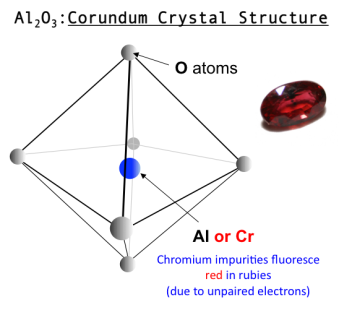 Since we’re in July, and I’ve been talking about rubies lately, I thought I’d cover a very important part of what makes ruby burn with such crimson glory: literally, what makes a ruby a ruby. There is some science involved; some parts of consumer education are more complex than others, but don’t be afraid. It’s not too complicated. I promise.
Since we’re in July, and I’ve been talking about rubies lately, I thought I’d cover a very important part of what makes ruby burn with such crimson glory: literally, what makes a ruby a ruby. There is some science involved; some parts of consumer education are more complex than others, but don’t be afraid. It’s not too complicated. I promise.
Chromophores are molecules of an element in a material substance that give it color. Every material substance in the world that is not transparent and colorless has chromophores, from tractor tires to chicken marsala. All gemstones have chromophores, too. Some, like malachite and peridot, are idiochromatic, which means their chromophore molecules are part of their essential chemical makeup.
Most colored gemstones in their purest chemical form are colorless when transparent or white when opaque. Emerald, aquamarine, morganite, ruby, sapphire, tanzanite, several varieties of garnet, tourmaline, zircon, alexandrite, spinel, topaz, the jades, quartz, opals, and diamonds are all allochromatic (“other colored”) gemstones. They would be colorless or opaque white without these trace coloring impurities, or chromophores. Barring optical phenomena (like in opals), they would all look much the same to the untrained eye.
Chromophores in gems can be trace impurities that are not part of their essential chemical makeup. Chromophores can also be structural defects called “color centers.” A handful of gems, like some natural purple diamonds, can even be colored by a combination of both impurities and color centers.
There are many elemental chromophores in the gem world, but there is one that contributes more than most others. Five of the rarest and most valuable gemstone varieties in the world get their colors from chromium.
Ruby is the best example, where chromium ions absorb all but the most intense red rays of light so that they can be returned to the eye. In sizes over ten carats, fine ruby is generally regarded as the most expensive commercially available gemstone per carat in the world. At the Sotheby’s Magnificent Jewels auction in Hong Kong earlier this year, a 29.62 carat ruby sold for US$7,338,462: a new record for ruby.
The historic Colombian emeralds are colored by chromium, as well. In fact, there are some countries that – no matter what the intensity of the green – will not consider a beryl to be an emerald unless it is colored by chromium. While this stringent opinion is not held by all experts, chromian emeralds arguably achieve the most premiere greens in the gem world.

Russian demantoid garnet stud earrings.
Russian demantoid garnet from the Ural Mountains has a high concentration of chromium, creating a green that is unrivaled by other deposits of demantoid. Namibian deposits have low chromium content and rely more on vanadium for their color. Iranian demantoid has more chromium, but nowhere near the breathtaking greens of the Uralian material. The newest deposits found in Madagascar are indeed andradite garnets, just like Russian demantoid, but they contain no chromium whatsoever; Madagascan material primarily gets its color from iron.
Alexandrite gets its world-renown color-change capabilities from the same chromium +3 ions that color both ruby and emerald. Without chromium, alexandrite would simply be chrysoberyl, which is a fine gem in its own right, but one that never captured the heart of a nation overnight as alexandrite captured the heart of Russia.
The finest grades of so-called “Imperial Jade” jadeite from Burma get their superior green from their chromium content, likely the same chromium tracts that color Burmese rubies. Pure green, unmottled, translucent jadeite commands premiums that skyrocket above any other cabochon gem and even most facetable gems, as well. The Hutton-Mdivani Necklace, a strand of twenty-seven translucent, color-matched, bright green jadeite beads, has set and broken the world record for most expensive piece of jadeite jewelry three times. It did so most recently also at the Sotheby’s Magnificent Jewels auction in Hong Kong, selling for US$27.44 million.
Here’s a link to the ruby and jadeite pieces I mentioned, which sold at Sotheby’s Magnificent Jewels:
It really is amazing how miniscule amounts of a substance on the molecular level can affect the rarity and beauty of a gemstone. Without chromium, some of the most spectacular gemstones in the world would look little different than glass.
Tags: alexandrite, chromium, chromophores, diamonds, gemstones, jadeite, ruby, Russia